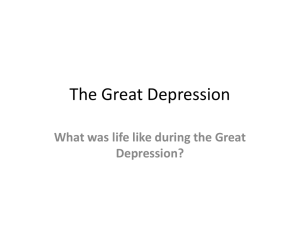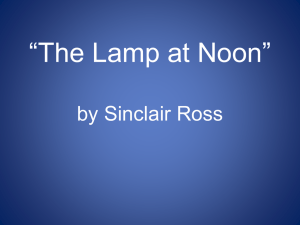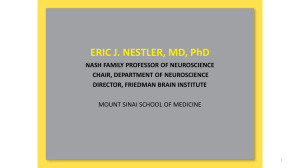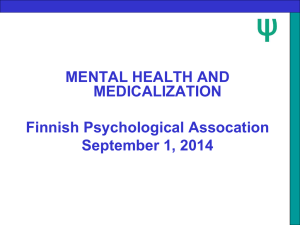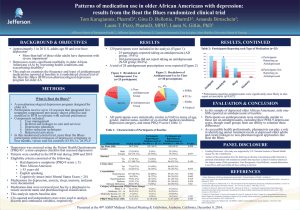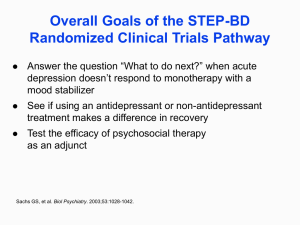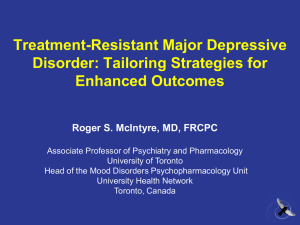PowerPoint
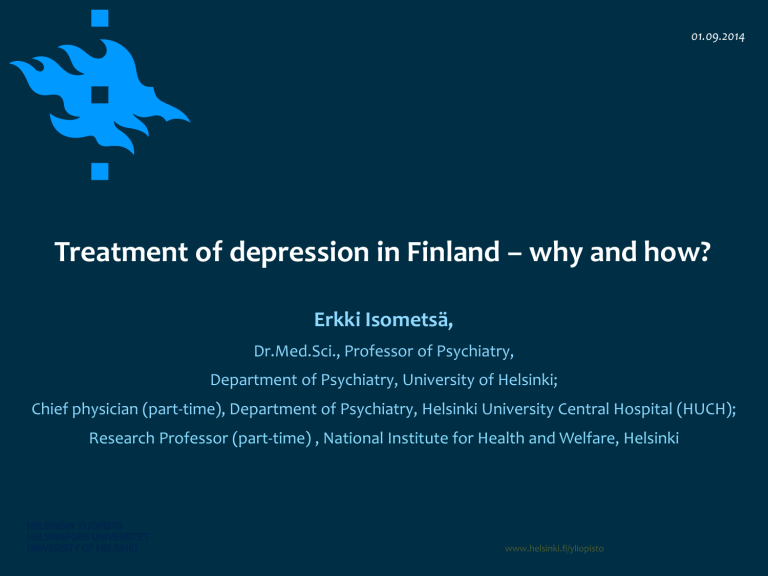
01.09.2014
Treatment of depression in Finland – why and how?
Erkki Isometsä,
Dr.Med.Sci., Professor of Psychiatry,
Department of Psychiatry, University of Helsinki;
Chief physician (part-time), Department of Psychiatry, Helsinki University Central Hospital (HUCH);
Research Professor (part-time) , National Institute for Health and Welfare, Helsinki www.helsinki.fi/yliopisto
Potential conflict of finterest disclosure: September 2011 – September 2014
• Employment by a pharmaceutical company:
• Research funding from a pharmaceutical company:
(Never)
(Never)
• Advisory Board or Speakers Bureau Membership: (Never)
• Honoraria for lecturing in educational meetings sponsored by a pharmaceutical company o Servier x 2 (2012)
• Honaria for lecturing, other o Finnish Medical Society Duodecim (2012) o Finnish Medical Association (2014) o European College of Neuropsychopharmacology, ECNP (2012) o Royal College of Psychiatrists (2012) o Columbia University (2013)
• Funding for participation in scientific meetings from pharmaceutical companies o Lundbeck x 1 (2012)
• Licensed psychotherapist (Valvira) o Income since 1989
1/273 inhabitants in 2013
medicalization ≠ pharmacotherapy
Why should depression be treated?
Depression and associated disability in Finland in 2012
Honkonen T & Gould R. SLL 44/2011
• Increase in disability pensions ended 2007.
• No. of sick leave periods 26 709 (no. parttime sick leaves 1980).
• New disability pensions granted due to depression for 3 549 individuals.
• Total no. of disability pensions for depression in Finland 36 358.
• Total costs involved > 600 million €.
Cumulative risk of completed suicide among subjects in psychiatric care in Denmark
Cumulative incidence, register-based follow-up to 36y. (median 18y.) since first treatment contact males females
Nordentoft M et al., Arch Gen Psychiatry 2011;68:1058-1064
.
Treatment: The Finnish Current Care Guidelines
Annual prevalence of depressive syndromes in the general population
<1% Psychotic depression
4-5% Depressive episodes and recurrent depression
Dg F32-33
10-15% mild depressive symptoms
Phases of treatment
Current Care Guidelines, 2009
6 mo.
relapse
Recurrent depression (F33) recurrence
Acute treatment
Continuation phase
Maintenance phase
Acute treatment of depression
Treatment modality Mild Moderate
Current Care Guidelines, 2009
Severe Psychotic
Psychotherapies +
Antidepressants
Antipsychotics
Electroconvulsive therapy
(ECT)
-
-
+
-
-
+
+
-
+
(+)
+
+
+
-
+
Psychotherapeutic treatment
Central forms of psychotherapy in different treament phases
Treatment modality Duration and intensity
Current Care Guidelines, 2009
Evidence in phases of treatment
Acute
Cognitive /
Cognitive-behavioural (CBT)
Interpersonal (IPT)
A
Brief MBCT (8-16x, 1x/wk)
Brief/medium-term CBASP (12-40x) -
-
Long-term (40-160x, 1-2x/wk)
Brief (12-16x, 1 x/wk)
D
A
Psychodynamic Brief (16-25x, 1x/wk)
Long-term (80-240x, 1-3x/wk)
B
B
-
D
MBCT = mindfulness-based cognitive therapy; CBASP = cognitive behavioral analysis system of psychotherapy
D
A
-
A
-
Continuation and maintenance
-
Chronic and/or complicated
-
-
B
C
-
B
Effectiveness of psychotherapy in depression?
• In the Helsinki Psychotherapy Study (HPS, N=326), patients depression/and or anxiety improved significantly on both brief and longterm psychodynamic as well as solution-focused therapies, but brief therapies were estimated not to be sufficient treatment in the majority of patients.
• In a study (N=341) comparing cognitive-behavioral vs. psychodynamic brief therapies (16 sessions in 22 wks) in outpatients psychiatric care in
Amsterdam, proportion of patients remitted 23% in both groups, responders 39% and 37% (Driessen E et al., Am J Psychiatry 2013;170:1041-50.)
• In the UK Improved Access to Psychological Therapies (IAPT) Project, a report of 7859 pts found 55% of patients improved after treatment.
However, attrition rate was 47%
(Richards & Borglin, J Affect Disord 2011;133:51-60).
Psychotherapy: the issue of capacity
• Overall 5475 licensed psychotherapist aged ≤ 65 y in 31.12.2013 (Valvira).
• In 2009-13, no. of registered new therapists varied annually between 275-432.
• Of Finnish psychotherapists in 2011, o ¼ were not currently providing psychotherapy o 85% provided individual therapy o Median time devoted to psychotherapeutic work 15h/wk o Estimated no. of patients treated per year 18 pts./therapist o Regional distribution uneven, 3-fold differences in density
Rough estimate: 40 -70 000 patients treated/year, in therapies of 1-3 y
Valkonen J et al. Psykoterapeutit Suomessa. Psykoterapiapalvelut ja niiden järjestäminen. KELA, 2011
Pharmacotherapy
Sales of antidepressant drugs in Finland in 1990-2012
• Altogether 444 184 individuals in 2012.
• DDD 69,81 (DDD 70,24 in 2011)
• Change from the year 2011: -1%.
• Likely causes of increase:
• Increased treatment-seeking and provision for depression, particularly in primary health care
• New treatment indications
• Continuation/maintenance treatment
Finnish Statistics on Medicines, 2012
Sales of antidepressant drugs in Finland in 1990-2012
• Altogether 444 184 individuals in 2012.
• DDD 69,81 (DDD 70,24 in 2011)
• Change from the year 2011: -1%.
• Likely causes of increase:
• Increased treatment-seeking and provision for depression, particularly in primary health care
• New treatment indications
• Continuation/maintenance treatment
Finnish Statistics on Medicines, 2012 Current Care Guidelines
Sales of antidepressants in the Nordic countries in 2005-2012
From: Health Statistics for the Nordic Countries; Nomesko, 2013
Typical 6-8 wk antidepressant trial response rates
60%
50%
40%
30%
20%
10%
0%
Spontaneous remission
Placebo Antidepressant
Typical 6-8 wk antidepressant trial response rates
60%
50%
40%
30%
20%
10%
0%
Spontaneous remission
Placebo Antidepressant
The THREAD Study (N=220) : Effectiveness of SSRI-treatment added to supportive treatment in UK primary care
Remission by 12 wks: 42% vs. 24%, NNT = 6 (95% l.v. 4-26)
Kendrick T et al. Health Technology Assessment 2009;13:22.
DOI:10.3310/htaI 3220
Phases of treatment
Current Care Guidelines, 2009
Acute treatment
6 mo.
relapse
Recurrent depression (F33) recurrence
Continuation phase
NNT 3-6
Maintenance phase
Conclusions
• Depression is associated with remarkable disability, significant excess mortality, and markedly elevated suicide mortality.
• In mild to moderate depression, there are no significant differences in efficacy or effectiveness between psychotherapies or antidepressants.
• In severe or psychotic depression pharmacotherapy or other biological treatment is usually needed.
• Combined and integrated treatments are needed and most effective.





